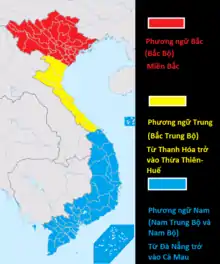越南語方言
現代越南語的發音以河內腔(北方方言)為標準。但是不少的海外越僑說的是西貢(南方方言)腔的越南語。海外的越南語媒體多數都用西貢腔廣播。河內腔跟西貢腔主要差別是在聲調和捲舌音上。
越南語方言,大致分做3類。三者間的差異主要在音韻和詞彙上,文法上的差異非常小。

Bản đồ phân bố 3 vùng phương ngữ chính của tiếng Việt tại Việt Nam
越南語方言分區
| 方言名稱 | 地区 | 舊名 |
|---|---|---|
| 防城方言 | 防城港市 | 東興方言 |
| 北部方言 | 河内、海防等地 | 東京方言 |
| 清化方言 | 乂安(荣市、清漳)、清化、广平、河静 | 上安南方言、北中方言 |
| 中部方言 | 顺化、广南 | 上安南方言 |
| 南部方言 | 胡志明市、湄公河三角洲 | 交趾支那方言 |
音韻差異
在河內腔中,後面3組的字母並沒有發音上的差別:tr=ch=[tɕ]、d=r=gi=[z]、s=x=[s]。但是在西貢腔中,r、s、tr需要捲舌,ch、gi、x 沒有捲舌。而且西貢腔將 d 唸做半元音[j]。
| 捲舌音 | 平舌音 | 半元音 | 現代標準音 |
|---|---|---|---|
| tr | ch | tr=ch=[tɕ] | |
| r | gi | d | r=gi=d=[z] |
| s | x | s=x=[s] |
在聲調上,西貢腔將跌聲(陽上)歸併到問聲(陰上)。所以,西貢腔的越南語只有5個聲調。
聲母差異對比
聲母差異對比 音節位置 拼寫法 北部 北中部 中部 南部 syllable-initial x [s] [s] [s] [s] s [ʂ] [ʂ] [ʂ] ch [tɕ] [tɕ] [tɕ] [tɕ] tr [tʂ] [tʂ] [tʂ] r [z] [ɹ] [ɹ] [ɹ] d [z] [j] [j] gi [ɟ] v [1] [v] [v] syllable-final c [k] [k] [k] [k] t [t] [t] t
after e[k, t] t
after ê[t] [t] t
after i[t] ch [c] [c] ng [ŋ] [ŋ] [ŋ] [ŋ] n [n] [n] n
after i, ê[n] [n] nh [ɲ] [ɲ]
l, n 對比
l, n對比 拼寫法 "Mainstream" varieties Rural varieties n [n] [n] l [l]
詞彙差異
底層詞彙差異對比[2] 北部方言 中部方言 南部方言 漢語 này ni nầy "這" thế này ri vầy "因此" ấy nớ, tê đó "那" thế, thế ấy rứa, rứa tê vậy đó "因此,所以,這種方式" kia tê đó "that yonder" kìa tề đó "that yonder (far away)" đâu mô đâu "哪裡" nào mô nào "哪個" sao, thế nào răng sao "怎麼,爲什麽" tôi tui tui "我(禮貌用語)" tao tau tao, qua "我(日常用語)" chúng tôi bầy tui tụi tui "we, us (but not you, polite)" chúng tao bầy choa tụi tao "咱们(but not you, arrogant, familiar)" mày mi mầy "you (thou) (arrogant, familiar)" chúng mày bây, bọn bây tụi mầy "you guys, y'all (arrogant, familiar)" nó hắn, nghỉ nó "he/him, she/her, it (arrogant, familiar)" chúng nó bọn hắn tụi nó "they/them (arrogant, familiar)" ông ấy ông nớ ổng "he/him, that gentleman, sir" bà ấy mệ nớ, mụ nớ, bà nớ bả "she/her, that lady, madam" cô ấy o nớ cổ "she/her, that unmarried young lady" chị ấy ả nớ chỉ "she/her, that young lady" anh ấy eng nớ ảnh "he/him, that young man (of equal status)"
注釋
- In southern dialects, v is reported to have a spelling pronunciation (i.e., the spelling influences pronunciation) of [vj] or [bj] among educated speakers. However, educated speakers revert to usual [j] in more relaxed speech. Less educated speakers have [j] more consistently throughout their speech. See: Thompson (1959), Thompson (1965: 85, 89, 93, 97-98).
- Table data from Hoàng (1989).
This article is issued from Wikipedia. The text is licensed under Creative Commons - Attribution - Sharealike. Additional terms may apply for the media files.
